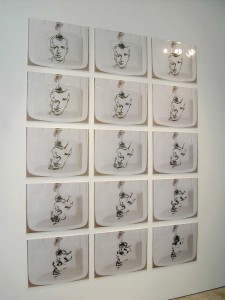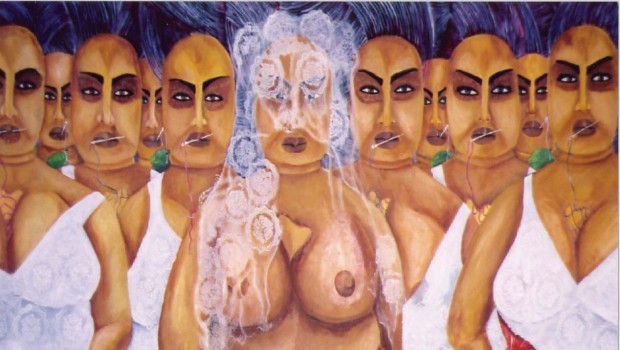Oscar Muñoz: Self and Others
Fernando Castro R.
Download Complete PDF / Descargar
Oscar Muñoz’s oeuvre bridges the gap between self and others, between egocentrism and altruism. His works engage the viewer by their interactive nature, by derailing accepted technical practices, and/or by astute provocation. Although Muñoz’s works are sparked by the violence and human rights violations in his native Colombia, they quickly evolve into a reflection about both the folly and compassion of humanity.
Muñoz’s series of self-portraits called Narcissi deliberately revisit the Greek myth of Narcissus–attributed mainly to the Roman poet Ovid. It is about a youth whose beauty induced many maidens to fall desperately in love with him. One of them was Echo, a beautiful nymph who had been punished by the goddess Hera to never speak but only repeat what others said. Echo followed Narcissus around but could not speak to him. Once when Narcissus was in the woods he called for his friends: “Is there anyone here?” Echo echoed, “Here, here.” Narcissus responded, “Come.” “Come,” she repeated as she came out of her hiding place with her arms outstretched. Narcissus shunned her in disgust saying, “I will die before I give you power over me.” “I give you power over me,” she repeated meekly, but he was already gone. In despair Echo sought solace in a cave and hid. Narcissus’s cruelty was punished by Nemesis, the goddess of righteous anger, who determined that “he who does not love others will love only himself.” One day, as Narcissus bent over a pool to drink, he saw his own reflection and fell in love with it. “Now I know the pain others have felt loving me, for I burn with love for myself,” he cried. “But how can I possess the beauty refl ected in the water? I cannot part with it. Only death can free me from this overpowering love.” To no avail the nymphs who had loved him looked for his body to give him a proper burial, for he had turned into the lovely flower which has born his name ever since.
These are not self-depictions à la Chuck Close or Lucas Samaras. Any verisimilitude or beauty in portraiture is preempted by their process of production. The original image of the self-portrait is photographic, but Muñoz transfers it to the mesh of the silkscreen process where it begins its decomposition.
With his Narcissi, Muñoz actualizes this myth with a series of distorted self-portraits drawn on shallow Plexiglas trays that feign as the pool in Ovid’s narrative. These are not selfdepictions à la Chuck Close or Lucas Samaras. Any verisimilitude or beauty in portraiture is preempted by their process of production. The original image of the self-portrait is photographic, but Muñoz transfers it to the mesh of the silkscreen process where it begins its decomposition. However, instead of following the usual course of silkscreen production, he places the screen over a shallow tray with water about an inch deep. Once the screen is as close to the liquid surface as possible, Muñoz sprinkles very fine charcoal dust over the mesh so that it goes through only where it is not blocked by the image on the screen. Thus the black dust draws an ephemeral self-portrait that floats on the surface of the water. As time, motion, and air movement ravage it, the drawing becomes increasingly distorted. The image continues to decompose until the water slowly evaporates and the charcoal dust settles at the bottom of the tray where the image is fixed. This process brings to mind another myth–one found in Genesis: “for dust thou art, and unto dust shalt thou return.”
 Another work by Muñoz is a group of circular polished steel mirrors called Aliento (breath). The perfectly refl ective surface of each mirror hides the photographic image of a different victim of political violence. The invisibility of the victim’s face is the result of the transparent greasy medium Muñoz uses to print it on the mirror. As the viewer approaches the mirror, she sees only her own specular image, but as she gets close enough to the mirror so that her breath fogs its surface, the concealed image becomes visible. For as long as the viewer continues to breathe on the mirror, the other’s face is visible. As soon as the viewer stops giving her “breath” to the image (the secondary meaning of aliento is “encouragement”) the victim’s image vanishes and the viewer’s own face reappears.
Another work by Muñoz is a group of circular polished steel mirrors called Aliento (breath). The perfectly refl ective surface of each mirror hides the photographic image of a different victim of political violence. The invisibility of the victim’s face is the result of the transparent greasy medium Muñoz uses to print it on the mirror. As the viewer approaches the mirror, she sees only her own specular image, but as she gets close enough to the mirror so that her breath fogs its surface, the concealed image becomes visible. For as long as the viewer continues to breathe on the mirror, the other’s face is visible. As soon as the viewer stops giving her “breath” to the image (the secondary meaning of aliento is “encouragement”) the victim’s image vanishes and the viewer’s own face reappears.
It would not be a digression from the main political message of the work to point out that therein is also some refl ection about how photographic images keep alive the memories of their subjects. A mug-shot of an unidentified person is part of nobody’s memory. In other words, the memory of someone endures not so much because there is an image of him/her but because somebody thinks about him or her. Moreover, the viewer can be moved by Muñoz’s works to moral concern about acts of violence, but as long as the image is not identified as being of a particular individual, he/she cannot be moved to demand justice for that person and his/her victimizer.
In Lacrimarios (tear containers), Muñoz uses some of the same technical strategies as in the Narcissi; i.e., he uses a silkscreen mesh to draw an image on the water, although in these works the water is inside a glass cube filled almost to the top. The glass cube is sealed so that as time passes, water condenses on the inside of the top glass, forming tearlike droplets. The idea of water condensing inside a glass cube is not new. Hans Haacke built a similar cube circa 1964 for a work titled Condensation Cube. Haacke’s cube, however, was larger and had very little water in it. The condensing water formed droplets which slowly dripped on each of the four interior faces of the cube, “drawing” lines and other patterns on the glass. The droplets in Muñoz’s Lacrimarios function differently than in that exemplary work of concrete art; for they denote tears that stand between the viewer and the floating photographic charcoal image–as if the victim inside the cube were looking at the world outside through a curtain of tears, or as if the viewer outside were looking at the image inside through a layer of tears. A beam of light that shines from below the cube reflects the image on several of its faces and on the wall where the cube hangs. Lacrimarios is a series in memoriam of a specific victim: an art student who was killed by one of the armed groups on the Pacific coast of Colombia. It is a region with one of the highest indices of humidity and precipitation in the world. Thus the droplets also allude to the environment where this particular act of violence was committed. As in the other works where the image is drawn with charcoal dust floating on water, it slowly decomposes until the face disintegrates.
Many of Muñoz’s works are characterized by their extreme fragility and vulnerability. The viewers who fog the mirrors of Aliento with their breath often end up spitting on them. These mirrors cannot be simply wiped clean without affecting the image–the latter needs to be restored. While in process, the Narcissi and Lacrimarios are fragile because with enough movement the floating image can be totally destroyed. Only when they dry up, do the Narcissi gain a certain degree of stability. But even this fragility of the works –so troubling for the collector–has a correlate in the interpretation of the work, for it denotes the tenuous relationships between viewers and victims, or between our image and us, between appearance and reality, or between art and reality. Muñoz programs his works to disintegrate, but it is precisely through that process of decomposition that the work fulfills itself and becomes a more conceptual entity.
The Narcissi are not the only works, in which Muñoz uses self-portraits. In his works self-portraits are not autobiographical in the sense of depicting episodes from his life; nor are they renderings of psychological states, or histrionic imposture à la Cindy Sherman. His depictions of himself and others are usually no more than mug-shots providing a minimal connection between image and referent. Although all Narcissi are made from the same silkscreen, no Narcissus is similar to another. In fact, some Narcissi resemble faces other than Muñoz’s more than they resemble him. These works point out not only the ephemeral nature of the object of narcissistic adulation but–as time makes us all alike–also to the futility of obsessive love for oneself. The youthful beauty that once shone in the mirror fades and all that remains are its traces: “vanity of vanities, all is vanity” (Ecclesiastes 1:2-5).
Posted: April 24, 2012 at 8:57 pm










